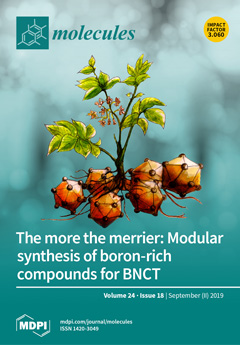Molecules, Volume 24, Issue 18 (September-2 2019) – 207 articles
The amount of boron that accumulates in tumor tissue plays an important role regarding the success of boron neutron capture therapy (BNCT). In this article, we report a modular system combining readily available starting materials, like glycine, 1,3,5-triazine, and the well-known 9-mercapto-1,7-dicarba-closo-dodecaborane(12), as well as α-D-galactopyranose for increased hydrophilicity, with a novel boron-rich tris-meta-carboranyl thiol.
Artwork by Dr. Christoph Selg View this paper.
- Issues are regarded as officially published after their release is announced to the table of contents alert mailing list.
- You may sign up for e-mail alerts to receive table of contents of newly released issues.
- PDF is the official format for papers published in both, html and pdf forms. To view the papers in pdf format, click on the "PDF Full-text" link, and use the free Adobe Reader to open them.






